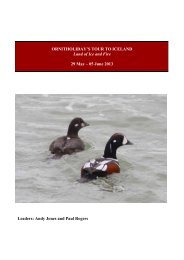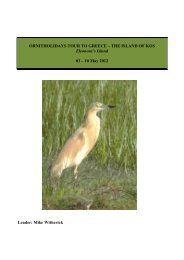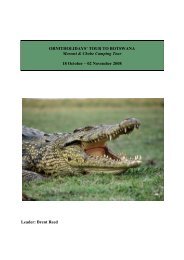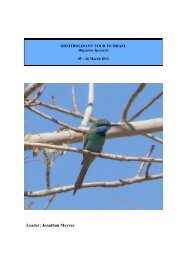Download 2014 Brochure (.pdf) - Ornitholidays
Download 2014 Brochure (.pdf) - Ornitholidays
Download 2014 Brochure (.pdf) - Ornitholidays
You also want an ePaper? Increase the reach of your titles
YUMPU automatically turns print PDFs into web optimized ePapers that Google loves.
K U W A I T<br />
Kuwait<br />
Birding in the Gulf<br />
Tuesday 01 April – Tuesday 08 April <strong>2014</strong><br />
Leaders: Nigel Jones and Dobromir Domuschiev<br />
<strong>2014</strong> Cost £2,799 single room supplement £380<br />
KUWAIT<br />
Kuwait<br />
City<br />
he small state of Kuwait, situated on the north-eastern corner of the Arabian Peninsula, lies at the<br />
Tvery south-eastern edge of the Western Palearctic but also on two major migration routes – Eurasia<br />
to Africa and Turkey to India. Due to these flyways, and despite its landscape being mainly a sandy desert, Kuwait is a great place to go birding. For certain<br />
species Kuwait is often the only place within the western Palearctic where you may find the following – Grey Hypocolius, Lesser Sand Plover, Red-vented<br />
and White-eared Bulbuls, Bank Myna, and Afghan Babbler. Beside these, many other highlights are here: Crab Plover, Greater Sand Plover, Socotra<br />
Cormorant, Red-wattled Lapwing, Greater Crested, Bridled and White-cheeked Terns, Egyptian Nightjar, Grey-headed Swamphen, Dunn’s Lark, Blackcrowned<br />
Sparrow-lark, Common Babbler, Blue-cheeked Bee-eater, Menetries’s and Upcher’s Warblers, Daurian, Turkestan and Steppe Grey Shrikes,<br />
Semi-collared Flycatcher, Pale Rock Sparrow, Cinereous Bunting, Persian Wheatear and many more.<br />
The coastline holds a considerable number of waders with Terek, Marsh and Broad-billed Sandpipers and Red-necked Phalarope all possible in addition<br />
to those already mentioned. We can also find many species of gulls including Great Black-headed, Armenian, Slender-billed and various races of the Lesser<br />
Black-backed as well as Bridled, White-cheeked, Lesser and Greater Crested Terns. Even small reedbeds can reveal virtually anything alongside views of<br />
Great, Clamorous and Basra Reed Warblers. On our recent recce trip we found over 15 crakes of three species (plus Water Rail) within 50 sq. metres. The<br />
oases and small farms scattered throughout the adjacent deserts also hold exciting species such as White-throated Robin, Persian, Desert and Pied<br />
Wheatears and numerous other passerines. Raptors may include Levant Sparrowhawk and Shikra, Pallid Harrier and Great Spotted Eagle. Plus there is<br />
always a chance for the Pallid Scops Owl.<br />
There is always the possibility of something really unusual to turn up, both for Kuwait and the Western Palearctic, and we can expect over 150 species in<br />
just a week. The beginning of April is the time when the migration is in full force, while we may still catch up with some of the wintering birds which are still<br />
in the area. It will already be warm, but not too hot, around 30 Celsius or so. This will require early starts, but we can return to the hotel for a siesta on some<br />
of the days. The hotel we have chosen is located at the edge of the city and to reach most the sites we will have very little driving through the traffic. We<br />
will spend the entire holiday in one hotel only, and it is not only perfectly situated near one of the major wetlands, but also has a swimming pool – a valuable<br />
asset in the middle of the day and in between excellent morning and afternoon birding sessions.<br />
ITINERARY<br />
Days 1 to 7<br />
We take a flight to Kuwait City where we arrive in<br />
the evening and transfer to our hotel where we<br />
stay for seven nights. We will have six full days to<br />
explore Kuwait and each day we will go to<br />
different areas, but some of the sites along the<br />
coast and wetlands near the hotel we will visit<br />
more than once and it also depends on the tides<br />
times. The furthest site requires no more than a<br />
90 minute drive to be reached.<br />
The city itself is a place where we will look for the<br />
Grey Hypocolius, Red-vented Bulbul and the<br />
Bank Myna, plus there will be many other<br />
migrating birds – Pied Wheatear, various<br />
subspecies of Yellow Wagtails, Red-throated<br />
Pipits and Ortolan Bunting which can be seen<br />
feeding on every tiny patch of green grass. All<br />
these can be found at the Green Island, Jahra<br />
City Park and Jahra Fields.<br />
The coast will produce most of the birds we will<br />
see during the holiday – Sulaibikhat Bay, Jahra<br />
pools, Jahra east outfalls, Doha spit and Doha<br />
south are all excellent spots for birding,<br />
especially during migration. Gulls, waders –<br />
Terek, Marsh and Curlew Sandpipers, also Rednecked<br />
Phalaropes, Gull-billed Terns, even<br />
raptors migrating through such as Greater<br />
Spotted Eagle, Lesser Kestrel and Levant<br />
Sparrowhawk. The few fresh water wetlands and<br />
the outfalls will add even more species –<br />
warblers, crakes and more waders. The<br />
adjacent fields should reveal Upcher’s Warbler,<br />
Steppe Grey and Daurian Shrikes, Eastern<br />
Grey Hypocolius<br />
70<br />
For a previous tour report or further information please call: 01794 519445








